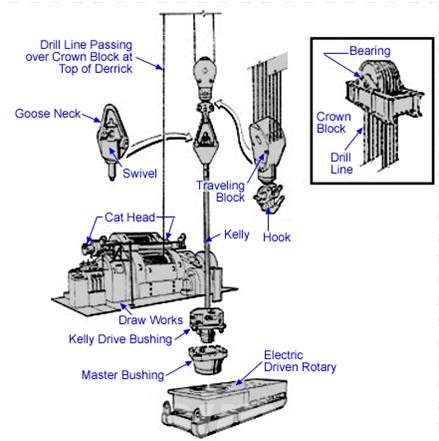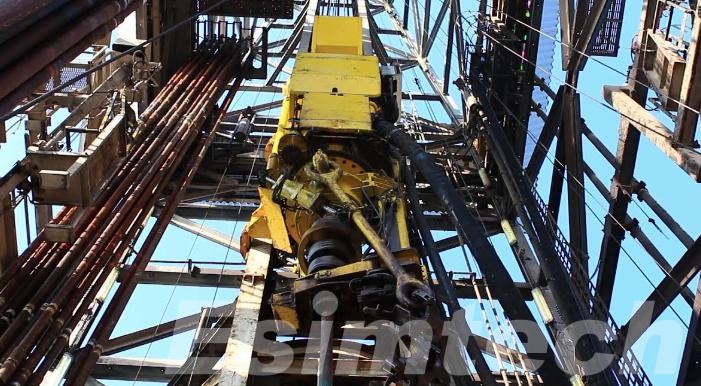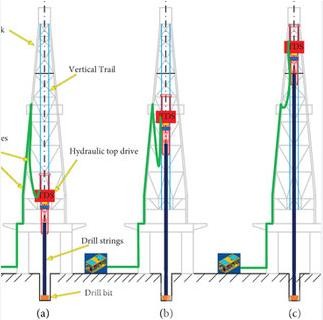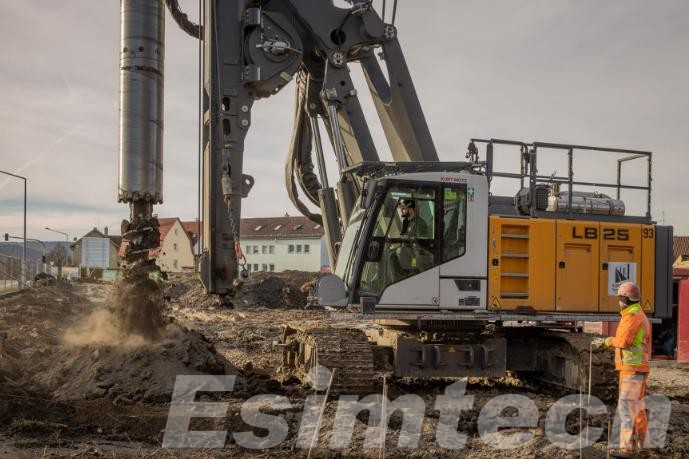Top Drive vs. Kelly Drive Drilling: A Look at the Modern Approach to Drilling
For decades, the drilling industry relied on a tried-and-true method: Kelly drive drilling. However, with the constant push for efficiency and safety, a more modern approach has emerged – the top drive drilling system. This article will delve into the differences between these two methods, highlighting the advantages of top drive drilling and its dominance in the future of the industry.
The Traditional Approach: Kelly Drive Drilling

The Kelly drive system revolves around a long, hollow steel bar known as the Kelly bar. This bar acts as a crucial intermediary between the surface and the downhole environment. Here’s a breakdown of the operation:
- Drill String Assembly: Individual drill pipes, each several meters long, are screwed together to form the drill string that reaches deep underground.
- Lowering the Kelly Bar: The Kelly bar is lowered down the wellbore, its bottom section interlocking with the uppermost drill pipe.
- Rotary Power Transfer: The rotary table at the surface spins, transmitting this rotation through the Kelly bar to the entire drill string. This, in turn, rotates the drill bit at the bottom, pulverizing rock formations.
- Adding Drill Pipe: As drilling progresses, the wellbore gets deeper. To extend the reach of the drill bit, operations must come to a halt. The Kelly bar and drill string are hoisted out of the hole. A new drill pipe is added to the top, and the entire assembly is then lowered back down the wellbore. This stop-and-start process is repeated throughout the drilling operation.
While the Kelly drive system served its purpose well, it comes with inherent limitations that hinder efficiency and safety:
- Time-Consuming Process: The constant need to stop operations, extract the drill string, add a new pipe, and re-lower everything adds significant time to the overall drilling process. This can be particularly problematic in deep well applications where drill pipe extensions become frequent.
- Labor Intensive: Manual handling of the heavy Kelly bar and drill string is a labor-intensive task, requiring a significant crew size. This not only increases operational costs but also introduces potential safety hazards associated with manual lifting and maneuvering of these weighty components.
- Limited Depth Capability: The length of the Kelly bar itself restricts the maximum depth a well can reach. Extremely deep wells become impractical and uneconomical with Kelly drive systems due to the cumbersome process of adding ever-longer drill strings.
Despite these limitations, Kelly drive drilling remains a valuable method in specific scenarios. For shallow well applications or situations where budgets are a prime concern, Kelly drive drilling can be a suitable option. However, for modern drilling operations demanding speed, efficiency, safety, and the ability to reach greater depths, top drive drilling has become the clear leader.
The Modern Approach: Top Drive Drilling

The top drive drilling system revolutionized the drilling industry by offering a more efficient, safer, and versatile alternative to the traditional Kelly drive method. Here’s a deeper dive into how top drives operate and the specific advantages they bring to the table:
The Mechanics of Top Drive Drilling
- Powerful Motor: The heart of the top drive system is a high-horsepower electric or hydraulic motor suspended from the top of the drill rig. This motor directly connects to the drill string via a rotary swivel.
- Continuous Rotation: Unlike the stop-and-start nature of Kelly drive drilling, the top drive motor provides constant rotation to the drill string. This uninterrupted rotation translates to faster drilling progress and improved hole quality.
- Automated Pipe Handling: Top drives often come equipped with automated pipe handling systems. These systems allow for adding or removing drill pipes on the fly, eliminating the need for manual handling and frequent rig shutdowns. This not only saves time but also minimizes safety risks associated with manual pipe handling.
- Real-time Data Integration: Modern top drives can integrate seamlessly with real-time data acquisition systems. Sensors on the top drive and downhole tools provide valuable information on factors like torque, weight on bit, and formation characteristics. This data allows drillers to optimize drilling parameters, improve wellbore control, and make informed decisions throughout the drilling process.

Advantages of Top Drive Drilling
- Increased Efficiency: Continuous rotation, automated pipe handling, and faster tripping (adding or removing drill pipe) significantly reduce drilling times compared to Kelly drive systems. In some cases, drilling times can be cut in half.
- Enhanced Safety: By eliminating the need for manual handling of heavy drill pipes, top drives minimize worker exposure to potential hazards like crushed fingers or back injuries.
- Improved Wellbore Control: Precise and continuous rotation allows for better control of the drill string, leading to a more stable wellbore and reduced risk of wellbore collapse. This is especially crucial in challenging formations or directional drilling applications.
- Greater Depth Capability: Top drives are not limited by the length of a Kelly bar. They can handle much longer drill strings, enabling operators to reach deeper target formations.
- Versatility: Top drives are well-suited for a wide range of drilling applications, from shallow onshore wells to deepwater offshore exploration. Their adaptability makes them a valuable asset for any drilling operation.
In conclusion, top drive drilling systems offer a significant leap forward in drilling technology. Their efficiency, safety features, and versatility make them the dominant force in modern drilling operations, paving the way for a more productive and safer future for the industry.

Top Drive vs. Kelly Drive: A Side-by-Side Comparison
The choice between Kelly drive and top drive drilling hinges on several key factors. Here’s a more detailed breakdown to help you understand the strengths and weaknesses of each method:
| Feature | Kelly Drive Drilling | Top Drive Drilling |
| Rotation Method | Kelly bar connected to rotary table at the surface | Top drive motor directly rotates entire drill string |
| Efficiency | Time-consuming due to frequent stops for adding drill pipe (tripping) | Significantly faster drilling times with continuous rotation and on-the-fly drill pipe addition |
| Safety | Higher risk associated with manual handling of heavy Kelly bar and drill string | Reduced risk by eliminating manual handling and improving control |
| Depth Capability | Limited by the length of the Kelly bar (typically 30-45 feet) | Enables drilling of deeper wells due to ability to handle longer drill strings (hundreds of feet) |
| Labor Requirements | More labor-intensive, requiring crews to operate elevators and handle drill pipe manually | Less labor required for operation, with automation playing a larger role |
| Cost | Lower initial equipment cost | Higher initial equipment cost, but offset by increased efficiency and reduced labor needs in the long run |
| Wellbore Control | Limited control due to intermittent rotation during tripping | Improved wellbore control due to continuous rotation and precise adjustments through the top drive motor |
| Data Acquisition | Integration with data acquisition systems can be challenging due to interruptions during tripping | Seamless integration with real-time data acquisition systems for better wellbore monitoring and optimization |
| Applications | Suitable for shallow wells, less demanding formations, or low-budget operations | Ideal for deep wells, complex formations, high-volume drilling projects, and environments where safety and efficiency are paramount |
The Future of Drilling: Top Drives Take the Lead
The future of drilling is undeniably colored by top drives. Technological advancements are pushing the boundaries of what’s possible. More powerful and efficient motors are enabling even faster drilling times and deeper wellbores. Improved control systems are leading to greater precision and accuracy during drilling operations. The potential for automation in top drive systems is another exciting development. Automating repetitive tasks can further enhance safety and reduce human error. Additionally, top drives can seamlessly integrate with real-time data acquisition systems. This allows for continuous monitoring of drilling parameters, enabling engineers to optimize wellbore design and drilling strategies on the fly. Top drives are not just a modern drilling approach; they are a platform for innovation that will continue to revolutionize the industry for years to come.

